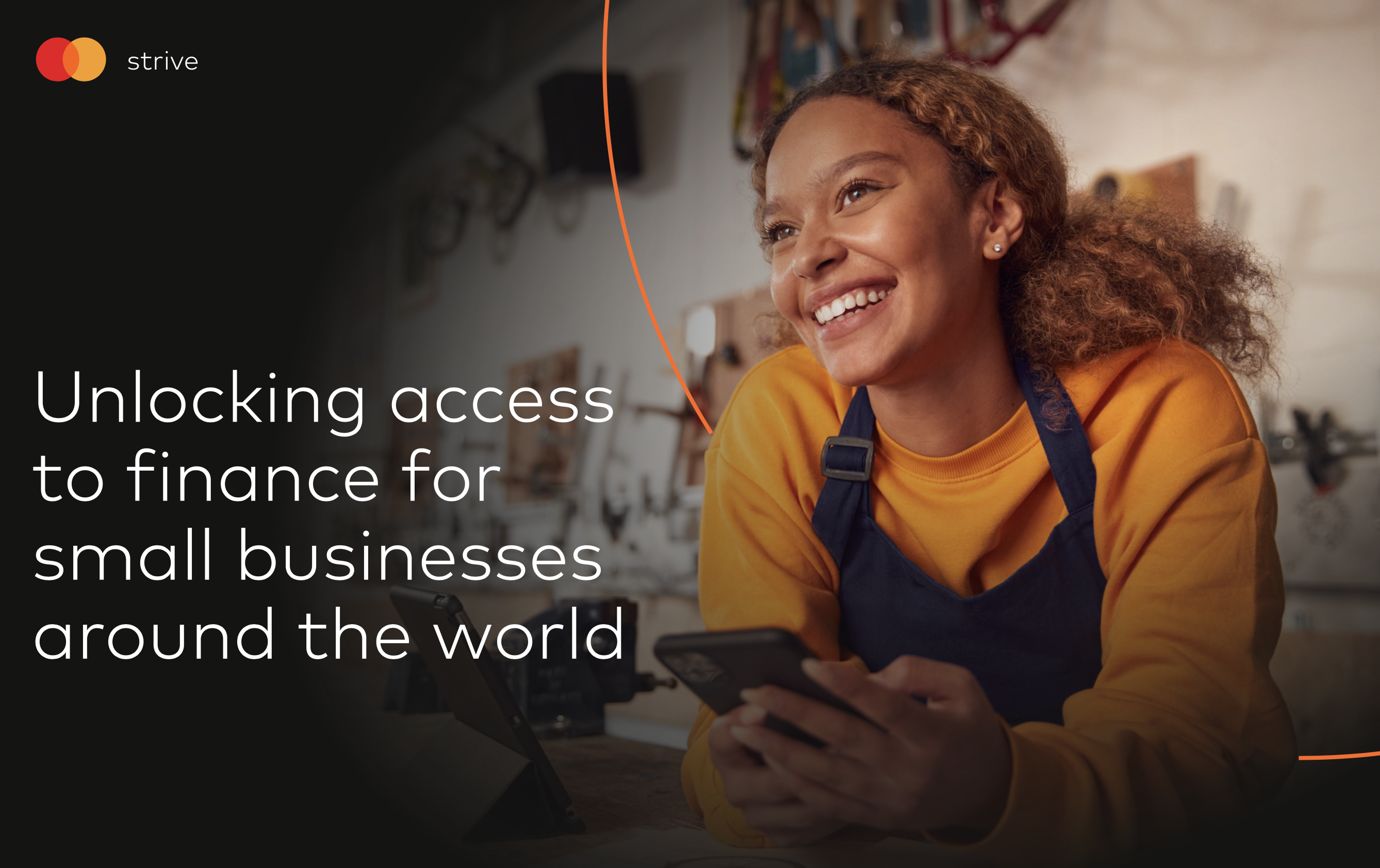Access to finance
This insights page is regularly updated and highlights what Strive Community is learning about digital credit for small businesses. Do you have best practices or insights to share about this topic? Reach out to us.
Introduction
Small firms make up the vast majority of businesses and more than 50% of employment worldwide. But they continue to be constrained by limited access to finance. Access to finance is critical to the development and growth of micro and small enterprises (MSEs), but there are few financial solutions that account for their nuanced and diverse needs. The IFC estimates that the annual financing gap for MSEs in developing countries is USD 5.2 trillion in the formal sector and USD 2.9 trillion in the informal sector. East Asia and the Pacific account for the largest share (46%) of the total global finance gap, followed by Latin America and the Caribbean (23%) and Europe and Central Asia (15%). The COVID-19 pandemic further compounded this shortfall as financing from traditional banks dried up.
When seeking credit, many small businesses fall into the “missing middle”: too big for microfinance but too small for commercial banks. They lack funds to better manage cash flow and daily operations, acquire assets, or grow through expansion. Small and medium firms report significantly higher financing obstacles than large firms. Several constraints prevent small businesses from accessing finance, including lack of collateral, high borrowing costs, lack of traditional data to assess credit risk, onerous documentation, and information asymmetry. Women-owned small businesses often are more credit-constrained than their men-owned counterparts (learn more about women-owned small businesses in our dedicated insight brief). Digital credit solutions can mitigate many of these constraints by enabling alternative data sources for assessing risk, cost-effective borrowing, and streamlined and fast application processes.
Digital lending solutions have gained increasing traction in recent years as a convenient and quick way for small businesses to access credit. Digital lending has been particularly relevant for small business owners whose credit histories have traditionally not been captured or were non-existent and who are often excluded from formal credit markets. Digital credit solutions can increase financial access, build resilience, and drive employment and investment.
While the instant, automated, and remote attributes of digital credit can mitigate many of the lending constraints that small businesses experience, they can also introduce new consumer risks. For instance, aggressive digital marketing, confusing user menus or interfaces, or limited debt capacity analysis can lead to increased consumer protection challenges. Small businesses need responsible digital credit solutions that offer:
- appropriate product design and delivery;
- prevention of over-indebtedness;
- transparency;
- responsible pricing;
- fair and respectful treatment of clients;
- data privacy;
- mechanisms for complaint resolution; and
- security and fraud prevention.
We are encouraged by policy and industry-led initiatives that foster and promote responsible digital lending.
Digital models that enable small businesses to obtain credit
Lending providers are leveraging digital tools and innovative models to offer digital credit solutions that address the persistent financing gap for small businesses. Five particular models of accessible digital credit for small businesses stand out.
E-commerce platforms: As a form of embedded finance, e-commerce providers offer credit to small businesses that sell on their platforms. In addition to functioning as a channel to reach small businesses, platforms can also augment loan decisions through data on the businesses, such as merchant cash flows, inventories, fulfillment performance, and other metrics. For instance, MYbank of Alibaba’s Ant Group evaluates a small business’s risk (years in operation, cash flows, business owner’s credit, etc.) and how the individual business compares to industry norms. Similarly, Jumia Lending offers loans to sellers on the Jumia Platform in Nigeria, Kenya, Ivory Coast, and Egypt based on vendors' sales history with Jumia and projections of future performance. Other platforms with similar offerings include Amazon Lending and Mercado Crédito.
Peer-to-peer lending platforms: Peer-to-peer (P2P) lending platforms match large numbers of lenders and borrowers, allowing holders of capital to lend to small businesses while reducing the costs of acquisition, assessment, and servicing for them. P2P lending platforms are particularly prevalent in Latin America. Afluenta (Latin America) generates a credit score for small businesses by cross-referencing uploaded company details with various data sources. To spread out the risk, the platform allows no single lender to provide more than 5% of a given MSE loan. Other P2P lending platforms include Faircent (India), Funding Societies (Southeast Asia), Kiva (global), and Firgun (Brazil).
Digital merchant cash advances: A digital cash advance is a lump-sum payment given to a merchant that is repaid via a percentage of daily credit and debit card sales. CGAP reports that fintechs using this model have non-performing loan ratios of as low as 3%. Many players offer cash advances, including Lendio, Square, PayPal Working Capital, Kopo Kopo Business Cash Advance, and many others.
Digitized supply chain finance: Supply chain finance (SCF) uses financing mechanisms to tie credit to the flow of goods through the supply chain. For example, Jaza Duka (a partnership between Mastercard and Unilever) is a digital platform in Kenya providing working capital to small merchants with a history of purchasing goods from Unilever. By digitizing payment histories with suppliers, this partnership helps KCB Bank assess credit risk and extend working capital to micro-retailers. Other examples include Tienda Pago (Mexico and Peru) and Nomanini (Kenya and South Africa).
Digital invoice financing: Invoice financing allows a small business to borrow capital against its unpaid customer invoices, improving its cash flow and enabling them to pay short-term expenses. Specialized financial firms calculate a discounted price for an invoice based on their risk criteria, such as the small business’s credit and invoice validity, and lend a percentage of the invoice's face value. Once a customer pays, the small business repays the lender. Examples include Lidya (Czech Republic, Nigeria, Poland, and the US), iwoca (UK), Bridgement (South Africa), and Cashinvoice (India).
Evidence on the impact of digital credit
Improved access to credit has demonstrated modest positive impacts on the average small business borrower. CGAP found that microcredit enabled some small business borrowers to scale their business operations or keep their businesses running (instead of becoming unemployed). It also highlighted that borrowers with an entrepreneurial mindset were more likely to be positively impacted by microcredit. The World Bank also found a strong positive relationship between access to finance and job growth, especially for small businesses.
For digital credit specifically, the evidence base for impact on small businesses is growing. In Kenya, researchers found that digital credit expands the options available to small businesses (rather than merely substituting existing services), especially for those who were previously unable to access credit through traditional methods. Similarly, in the US, researchers found that fintech lenders substantially expanded the small business finance market by reaching borrowers less likely to be served by traditional lenders. In France, research showed that loans distributed via fintech platforms alleviate the financial constraints of innovative small firms with limited collateral. In Uganda, research found that women who received a loan via mobile money had higher levels of business capital and higher business profits than women who received a loan via cash, because mobile money enabled women to circumvent pressures to share loans with other household members. In China, digital lending to small businesses following the onset of COVID-19 was positively associated with sales growth; firms that borrowed registered positive year-over-year sales growth rates, while those that did not had much lower, and even negative, rates. In Latin America, research found that the main business impacts on micro and small firms that had used digital solutions for funding were increased productivity, decreased costs, and an increased customer base. More recently, Accion (a Mastercard Center for Inclusive Growth partner) found that their MSE accelerator program, which worked to digitally transform financial service providers, contributed to particularly strong financial health improvements for micro and small businesses that had used an emergency digital loan.
Ultimately, compelling and widely applicable evidence of the impact of digital credit on small businesses is missing, and many unanswered research questions remain. In particular, the effectiveness of types of digital credit beyond microcredit and the depth of impacts of different product design features or borrower characteristics remains unclear.
Insights on how to support small businesses with digital credit
To better support small businesses to use digital credit to grow and increase their resilience, we’ve identified some recommendations below. We’ll continue to update these as we learn more from our partners and the wider community.
Design products that address day-to-day financial needs and behaviors
Providers that design financial products with the specific needs and behaviors of their target small businesses in mind are better able to increase product uptake, leading to improved customer resilience. Recent CGAP research advocates for the importance of a segmented approach to addressing small business needs (see our blog post that discusses this research). With a segmented approach across dimensions like the sector of operation, entrepreneurial mindset, growth stage, gender, and business size, CGAP argues that financial service providers can understand small businesses better and design and deliver more effective solutions. In Mexico, user research conducted by Accion and Caja Bienestar, a socially-focused financial institution, found that most microentrepreneurs in their target user group had difficulty understanding interest rate calculations. With this in mind, Caja Bienestar designed a fee-based digital credit product, leading to improved financial well-being and greater resilience among micro-entrepreneurs.
In addition to keeping small business needs and behaviors in mind, providers should also account for informality in their product design. Ninety percent of small businesses across the world still operate informally. Lucinda Revell, co-founder of Boost Capital (a Strive Community partner), explained that digital credit providers should not expect small businesses to keep perfect accounting or be able to provide a balance sheet. “You really have to design your products in a way that incorporates the informality of many small businesses,” she added. “It’s our role as the technology creator to bridge the divide between how the entrepreneur operates and what the bank needs.”
Engage in non-financial services to increase product use
Providers that combine financial products with non-financial services, such as training, mentoring, or networking, are better able to deepen the use and impact of digital financial products, leading to greater inclusion. In Ghana, researchers found that financial literacy positively affects access to digital finance for small businesses. Similarly, Arifu (a Strive Community partner) has found that its digital consumer education programs led to greater digital financial service use for its financial partners. Working within the Jaza Duka program, Arifu’s digital training on financial and business education for customers unintentionally led to a 21% increase in net borrowing, in addition to better repayment. In Cambodia, Boost Capital will test whether financial education can help entrepreneurs reduce their risk profile by becoming more financially savvy, better qualifying them for affordable financial services. While it may not be feasible for providers to develop their non-financial services to complement their products, partnerships to enable these can be advantageous.
Foster strategic and complementary partnerships
Digital finance is a rapidly evolving, highly competitive, and complex space. Mutually beneficial partnerships can be a valuable option to navigate this space—where each provider leverages its core strengths and assets to deliver innovative solutions. Partnerships can help providers reach new market segments, create new product offerings, better collect, use and manage data, and deepen customer engagement and product usage. These partnerships can enable providers to offer customers greater access to higher quality, more convenient, and cheaper financial products and services. For instance, in Spain, MicroBank partnered with US-based fintech Entrepreneurial Finance Lab (EFL) to extend access to credit to entrepreneurs with no credit history. EFL developed a psychometric scoring model to assess customers by asking them to complete an additional questionnaire exploring behavior and attitudes. This new model led to a 70–80% approval rate of credit requests, up from a 10–20% approval rate with traditional risk models.
Test and learn to deepen engagement
Digital credit providers that use a test-and-learn approach are better able to deepen engagement with small businesses, as they can continuously refine their product offerings. For instance, Singapore-based DBS Bank runs more than 1,000 experiments annually to better understand the needs of its customers. In Latin America, CÍVICO, a digital platform that connects citizens to local merchants, designed a low-fidelity lending prototype to test with small businesses and adapted it as they gathered more information about user behaviors and pain points. By testing and learning, CÍVICO could finetune which customers to target, thereby reducing risks for the organization and its partner-lending institutions. In Nigeria, Strive Community has partnered with Boost Technology to test a new service that combines data analysis, behavioral science, and conversational commerce to empower small retailers with insights to drive digital confidence, leading to increased access to finance. We also look closely at cultivating continuous learning practices in our insight brief on digital measurement.
Looking ahead
Innovative digital credit solutions that are responsibly designed and delivered will continue to offer small businesses access to funds enabling them to better manage cash flow and daily operations, acquire assets, or grow through expansion. Providers can better support small businesses to grow and increase their resilience by designing products that address their day-to-day needs, considering non-financial services to increase product use, partnering with other providers in strategic and complementary ways, and embracing a test-and-learn approach to product development. As we learn through our program and partners, we will continue to update these insights.
We encourage you to explore some of the Strive Community programs that address access to finance constraints for small businesses. As we learn through our program and partners, we will continue to update these insights.


